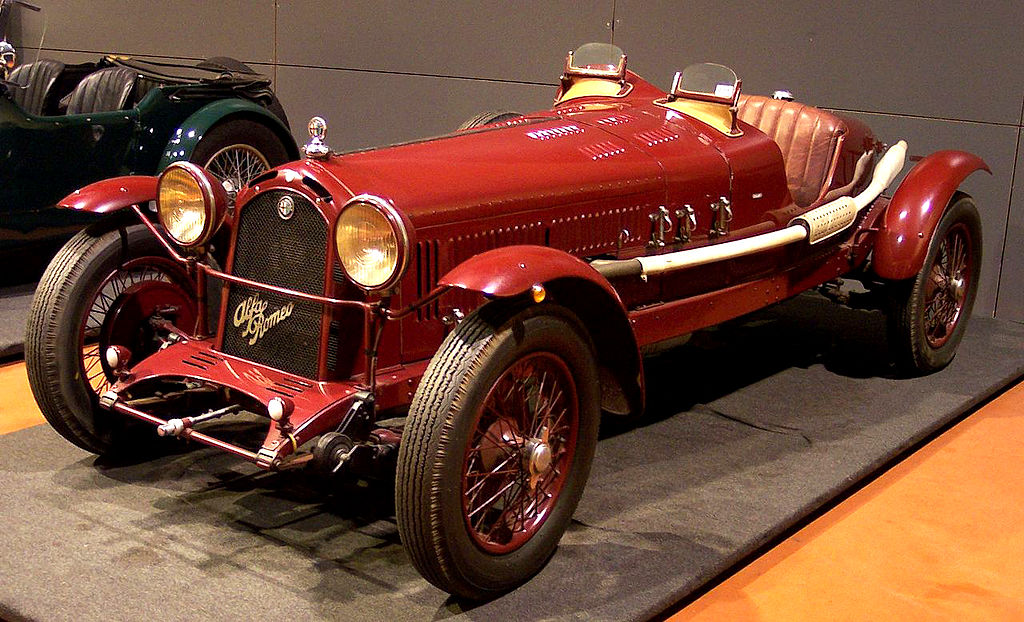Road cars
1921-1922 20-30 HP
ALFA or later Alfa Romeo has made three cars named as 20/30 HP, first one 1910 4-cylinder 4-6-seater tourer, improved version 20/30 HP E in 1914 and 1921 the 20/30 HP ES Sport, a 4-seater sportscar.
1920-1921 G1
The Alfa Romeo G1 was the first all-new design from Alfa Romeo after the end of the A.L.F.A. brand. Giuseppe Merosi, while engaged in a legal dispute with Nicola Romeo regarding the brand takeover conditions, designed the update for the prewar 24HP into the revised 20/30ES and the new luxury G1. The chassis was lengethened and stiffened from the 1914 40-60 HP model, entering into market territory competition with Rolls-Royce. A new 6.3 L (384 cu in) straight-6 engine was introduced, producing 70 bhp (52 kW) and 216 lb⋅ft (293 N⋅m) of torque. The G1 achieved a maximum speed of 86 miles per hour (138 km/h), winning its production class at the Coppa del Garda race. Total production was only 52 copies; it found virtually no customers in Italy and all 50 (bar 2 prototypes) found their way to Australia. Only one known survivoir exists; is owned by New Zealand's Alfa importer and is the oldest surviving Alfa Romeo-branded car.
1921-1921 G2
The Alfa Romeo G2, a planned improved version, was never produced after the commercial failure of the G1.
1922-1927 RL
The Alfa Romeo RL was produced between 1922-1927. It was Alfa's first sport model after World War I. The car was designed in 1921 by Giuseppe Merosi. It had a straight-6 engine with overhead valves. Three different versions were made: Normale, Turismo and Sport. RL total production was 2640. The RLTF (Targa Florio) was the race version of RL - it weighed half of normal versions, the engine had seven main bearings instead of four and double carburetors. In 1923 Alfa's race team had drivers like Ugo Sivocci, Antonio Ascari, Giulio Masetti and Enzo Ferrari. Sivocci's car had green cloverleaf symbol on white background and when he won Targa Florio 1923, that symbol was to become the Alfa team's good luck token.
In 1927, 2 different RLSS were entered in the first Mille Miglia, but both dropped out after briefly leading the race. A 1925 RLSS version with rare, original bodywork by Thornton Engineering Company in Bradford, UK, is on permanent display in the Brooklands exhibit at the Simeone Foundation Automotive Museum in Philadelphia, PA, USA. It is one of only 9 RLSS still in existence.
1923-1925 RM
Alfa Romeo RM was produced between 1923–1925, it was based on RL model. Car was introduced first time in 1923 Paris Motor Show and total production was around 500 cars. RM had 2.0 L straight-4 engine, which produced between 40 bhp (30 kW) to 48 bhp (36 kW). As most of Alfa Romeo cars this was also used in racing purpose. Three versions was made: Normal, Sport and Unificato. Sport had raised compression ratio and Unificato had longer wheelbase and slightly bigger engine. RM top speed was around 90 km/h (56 mph).
Models:
RM Normal, 1944 cc 40 bhp (1923)
RM Sport, 1944 cc 44 bhp (1924)
RM Unificato, 1996 cc 48 bhp (1925)
1927-1929 6C 1500
The Alfa Romeo 6C name was used on road, race, and sports cars produced between 1927 and 1954 by Alfa Romeo; the "6C" name refers to six cylinders of the car's straight-six engine. Bodies for these cars were made by coachbuilders such as James Young, Zagato, Touring, Castagna, and Pininfarina. Starting from 1933 there was also a 6C version with a factory Alfa body, built in Portello. In the early 1920s Vittorio Jano got a task to create a lightweight, high performance vehicle to replace the Giuseppe Merosi designed RL and RM models. The car was introduced in April 1925 at the Salone dell’ Automobile di Milano as the 6C 1500. It was based on the P2 racing car, using single overhead cam 1,487 cc inline six-cylinder motor producing 44 horsepower, in the 1928 was presented the 1500 Sport which was the first Alfa Romeo road car with double overhead camshafts.
1929-1933 6C 1750
The more powerful 6C 1750 (1752 cc actual) was introduced in 1929 in Rome. The car featured a top speed of 95 mph, a chassis designed to flex and undulate over wavy surfaces, as well as sensitive geared-up steering. It was produced in six series between 1929 and 1933. Base model had a single overhead cam; Super Sport and Gran Sport versions had double overhead cam engine (DOHC). Again, a supercharger was available. Most of the cars were sold as rolling chassis and bodied by coachbuilders such as Zagato, and Touring. Additionally, there were 3 examples built with James Young bodywork, one of which is a part of the permanent collection at the Simeone Foundation Automotive Museum in Philadelphia, PA, USA in original, unrestored condition.
In 1929, it won every major racing event it was entered, including the Grands Prix of Belgium, Spain, Tunis and Monza, as well as the Mille Miglia was won with Giuseppe Campari and Giulio Ramponi, the Brooklands Double Twelve and the Ulster TT was won also, in 1930 it won again the Mille Miglia and Spa 24 Hours. Total production was 2635.






















.jfif)




No comments:
Post a Comment